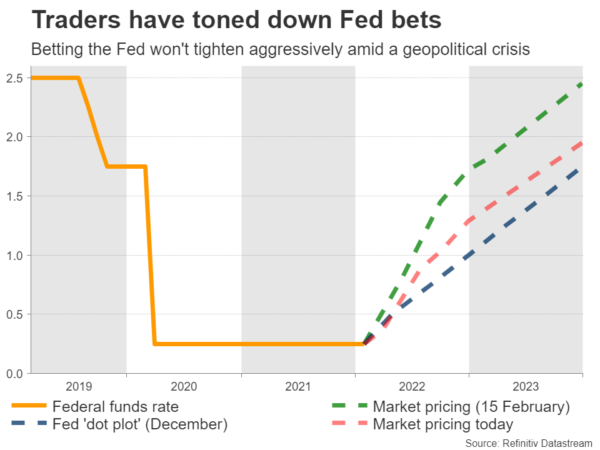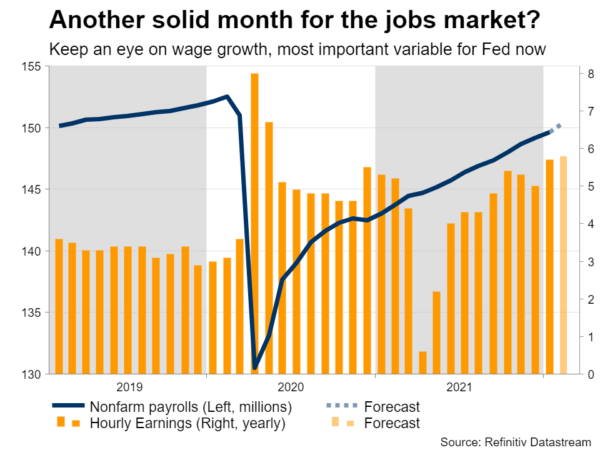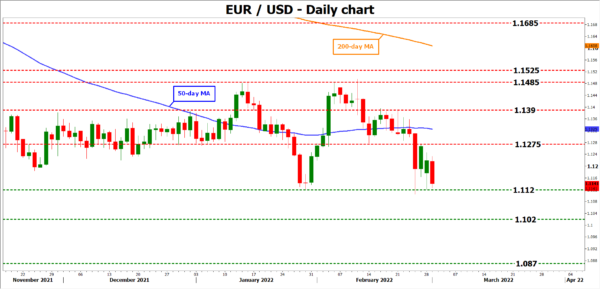The US dollar has been trading entirely as a safe haven asset since Putin rolled into Ukraine, but traders could turn their attention back to economics this week. The Fed Chairman will testify before Congress on Wednesday ahead of the all-important US employment report on Friday. Can the dollar continue to bulldoze its way through the FX complex?
Markets trade geopolitics
With the war in Ukraine still raging, global markets have been left hostage to geopolitical headlines. Demand for hedging has turned into the most important variable, overshadowing expectations around Fed policy as investors prioritize protection.
Naturally, the dollar has performed well in this environment. It has benefited both from its status as the world’s reserve currency and from a weaker euro as the Ukraine crisis will inflict much greater damage on Europe, both by crippling the banking sector and by pushing energy prices higher. America has neither problem as its banks aren’t exposed to Russia and it is energy independent.
But there will still be some effects on the US economy. With global energy prices charging higher, the concern is that inflation will remain elevated for longer. Some even speculated that the Fed would be forced to respond with faster rate increases.
However, traders have been betting on the opposite lately. Market participants have dialed back their bets for rate hikes in recent sessions, now pricing in roughly five rate increases for the year, down from six before the Ukrainian invasion.
Investors are essentially saying the Fed won’t dare to tighten aggressively in the middle of a geopolitical crisis and risk choking economic growth, even if that means a period of higher inflation.
Crucial events
We’ll find out whether the Fed truly believes that when Chairman Powell testifies before Congress on Wednesday. Then on Thursday, the ISM services survey for February will be released. But the main event will probably be on Friday, when the latest US employment report hits the markets.
Nonfarm payrolls are forecast to have risen by 438k in February, roughly as much as the previous month. That’s expected to have pushed the unemployment rate down by one tick to reach 3.9%.
Of course, the metric that markets will focus the most on is wage growth, which is projected to have accelerated a little in yearly terms. The Fed sees wage growth as an early indicator of inflationary pressures, so it is crucial for monetary policy.
As for potential surprises, most labor market indicators that have been released so far point to a solid report. The Markit composite PMI for the month showed that US businesses increased their employment levels at the strongest pace since May, while jobless claims fell during the week the jobs survey was conducted.
Can the dollar keep going?
As for the dollar, with so much demand for safe-haven assets right now and the geopolitical picture turning against the euro, the rally could continue. Technically speaking, euro/dollar is at a crucial crossroads. The pair has been trading sideways since November essentially and it is now testing the lower boundary of that range near 1.1120.
This week’s US events will likely decide whether we see the break. In case of a strong batch of data that forces traders to price in more aggressive Fed rate increases, the pair could pierce below that level and aim for the 1.1020 region afterwards.
On the other hand, a disappointment could dampen Fed rate hike bets even further, setting the stage for a rebound. If euro/dollar manages to break above 1.1275 again, the next target may be the 50-day moving average currently at 1.1325.
All in all, this is a very volatile market and making long-term predictions seems pointless. For now, everything depends on geopolitics and whether there’s a ceasefire in Ukraine soon. Economics could play a secondary role until then.
















